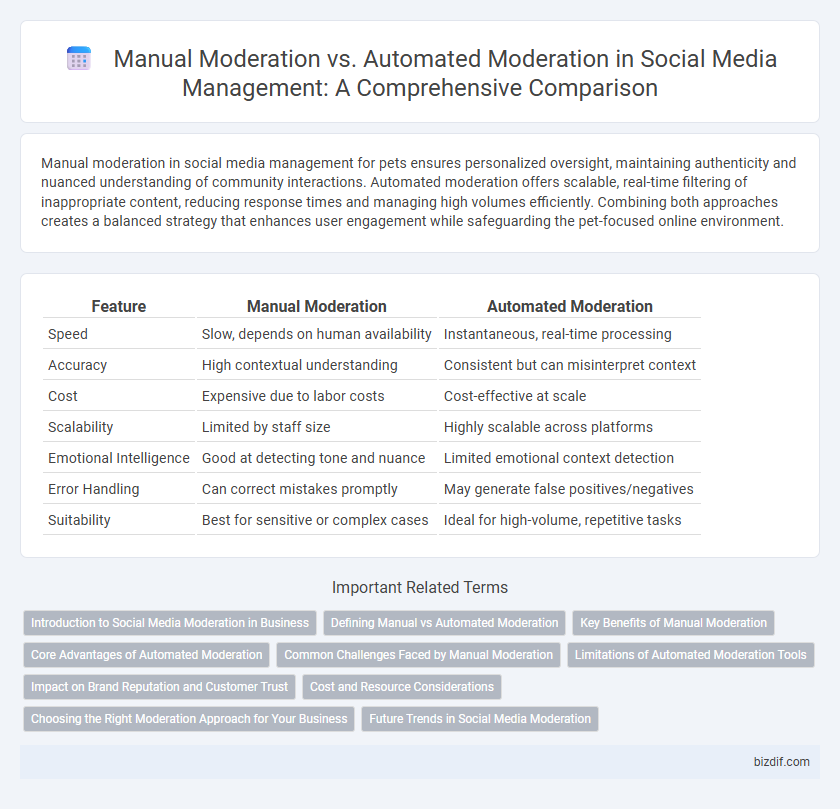Manual moderation in social media management for pets ensures personalized oversight, maintaining authenticity and nuanced understanding of community interactions. Automated moderation offers scalable, real-time filtering of inappropriate content, reducing response times and managing high volumes efficiently. Combining both approaches creates a balanced strategy that enhances user engagement while safeguarding the pet-focused online environment.
Table of Comparison
| Feature | Manual Moderation | Automated Moderation |
|---|---|---|
| Speed | Slow, depends on human availability | Instantaneous, real-time processing |
| Accuracy | High contextual understanding | Consistent but can misinterpret context |
| Cost | Expensive due to labor costs | Cost-effective at scale |
| Scalability | Limited by staff size | Highly scalable across platforms |
| Emotional Intelligence | Good at detecting tone and nuance | Limited emotional context detection |
| Error Handling | Can correct mistakes promptly | May generate false positives/negatives |
| Suitability | Best for sensitive or complex cases | Ideal for high-volume, repetitive tasks |
Introduction to Social Media Moderation in Business
Manual moderation in social media management involves human reviewers analyzing content for relevance and compliance, ensuring nuanced understanding and personalized responses. Automated moderation leverages AI algorithms and machine learning to quickly identify and filter inappropriate content, significantly enhancing efficiency and scalability in business contexts. Combining both methods optimizes brand safety, user engagement, and operational costs while maintaining high moderation quality.
Defining Manual vs Automated Moderation
Manual moderation involves human moderators who review and assess user-generated content based on community guidelines, ensuring nuanced understanding and context-specific judgments. Automated moderation uses AI algorithms and machine learning to detect and filter inappropriate content at scale, enabling real-time responses but sometimes lacking contextual accuracy. Both methods are essential in social media management, balancing speed and precision to maintain safe online communities.
Key Benefits of Manual Moderation
Manual moderation offers precise content filtering by leveraging human judgment to detect nuanced contexts, sarcasm, or subtle violations often missed by automated systems. This approach enhances community trust and ensures compliance with platform-specific guidelines, leading to higher-quality interactions and reduced false positives. Human moderators can adapt quickly to emerging trends and cultural shifts, providing a dynamic layer of oversight crucial for maintaining a safe and engaging social media environment.
Core Advantages of Automated Moderation
Automated moderation leverages artificial intelligence and machine learning algorithms to efficiently detect and filter inappropriate content at scale, drastically reducing response times compared to manual methods. It ensures consistent application of community guidelines across vast volumes of posts and comments, minimizing human error and bias. This scalability and precision make automated moderation essential for managing high-traffic social media platforms while optimizing operational costs.
Common Challenges Faced by Manual Moderation
Manual moderation in social media management often faces challenges such as scalability issues, inconsistent enforcement of community guidelines, and slower response times to inappropriate content. Human moderators may experience fatigue and bias, leading to reduced accuracy and potential oversight of harmful posts. These limitations highlight the need for more efficient moderation solutions to maintain safe and engaging online environments.
Limitations of Automated Moderation Tools
Automated moderation tools often struggle with understanding context, sarcasm, and cultural nuances, leading to potential misclassification of content. These tools can generate false positives by flagging harmless posts or false negatives by missing subtle harmful content, reducing overall accuracy. Reliance on algorithmic moderation may also overlook evolving slang or emerging threats, necessitating ongoing human oversight to ensure effective social media management.
Impact on Brand Reputation and Customer Trust
Manual moderation allows for nuanced understanding and personalized responses, enhancing brand reputation by ensuring sensitive issues are handled with care, which fosters stronger customer trust. Automated moderation excels in speed and consistency, effectively filtering inappropriate content to maintain a safe online environment, though it may occasionally misinterpret context, risking alienation of users. Balancing both approaches helps protect brand integrity while promoting reliable customer engagement on social media platforms.
Cost and Resource Considerations
Manual moderation demands significant labor costs and extensive human resources, often requiring dedicated teams for 24/7 monitoring to ensure content compliance and user engagement. Automated moderation reduces operational expenses by utilizing AI-driven tools to quickly filter inappropriate content but may still necessitate human oversight to address complex or nuanced cases. Balancing cost efficiency and resource allocation is crucial when integrating automated systems with manual moderation workflows to maintain effective social media management.
Choosing the Right Moderation Approach for Your Business
Selecting the ideal moderation approach for your business hinges on content volume, community engagement, and risk tolerance. Manual moderation ensures nuanced understanding and personalized responses, essential for brands valuing high-quality interactions. Automated moderation leverages AI and machine learning to efficiently handle large-scale content, offering rapid filtering of spam and inappropriate material, ideal for businesses prioritizing scalability and speed.
Future Trends in Social Media Moderation
Future trends in social media moderation emphasize the integration of AI-powered automated moderation to enhance scalability and real-time content filtering while reducing the workload of manual moderators. Advanced machine learning algorithms are evolving to better understand context, sentiment, and cultural nuances, improving the accuracy of automated systems in identifying harmful content. Hybrid moderation models combining manual expertise with AI-driven tools will likely dominate, ensuring ethical decision-making and adaptability to emerging social challenges.
Manual moderation vs Automated moderation Infographic

 bizdif.com
bizdif.com